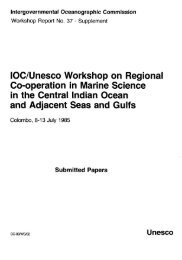The International thermodynamic equation of ... - unesdoc - Unesco
The International thermodynamic equation of ... - unesdoc - Unesco
The International thermodynamic equation of ... - unesdoc - Unesco
- No tags were found...
You also want an ePaper? Increase the reach of your titles
YUMPU automatically turns print PDFs into web optimized ePapers that Google loves.
75179 γPractical vs. Absolute SalinityA fundamentally different approach todetermining what’s in seawaterIn 1978, oceanographers agreed to use conduc-tivity as the universal method for estimating thesalinity <strong>of</strong> seawater. UNESCO endorsed thismethod, and incorporated the 1978 Practical Sa-linity Scale into its 1980 <strong>equation</strong>s for calculatingthe density <strong>of</strong> seawater (EOS-80).Prior to the Practical Salinity Scale, oceanogra-phers had primarily calculated salinity using titrationmethods that measured the most commonsalt ion: chlorine (see box on page 7: <strong>The</strong> searchfor salinity). <strong>The</strong> conductivity method improvedaccuracy, as it tracked all the ions in the sea andnot just chloride. But calculating salinity fromconductivity, as opposed to traditional chemicalanalysis, required sacrificing the definition <strong>of</strong>salinity. This is because conductivity measuresonly free-floating ions or electrolytes, the samedissolved salts that are found in sports drinks,for example. In fact, any non-conductive material,such as dissolved silicon dioxide, is simplyignored when it comes to practical salinity.Since seawater conductivity can only be preciselyrelated to salinity for a particular chemicalcomposition, applying the 1978 Practical SalinityScale to seawater <strong>of</strong> different compositions canlead to errors. <strong>The</strong>se errors are small in the openocean, but are much larger than the typical precision<strong>of</strong> modern measurements.Water from the North Atlantic with a salinity <strong>of</strong>about 35 parts <strong>of</strong> salt per thousand parts waterhas traditionally been used as a control for comparingother water samples. But as the waterfrom the Atlantic ocean travels around the world,the composition <strong>of</strong> the seawater changes as aconsequence <strong>of</strong> the biogeochemical differencesin the environment. Sinking particles remineralize,adding calcium, carbon and nutrients like silicicacid and nitrate. Once seawater comes intocoastal areas, its composition will also changeas it mixes with river waters, which have dissolvedions in very different combinations fromA Taste for Salt‘In chemistry, any positive and negative ionbound together is called a salt,’ explainsmolecular geneticist and chemosensation(taste and smell) expert Hiroaki Matsunami <strong>of</strong>Duke University in the USA. In the ocean, saltsdissolve into free-floating negative and positiveions, also known as electrolytes. <strong>The</strong>secharged particles are what make it possiblefor electricity to flow through water. <strong>The</strong> sameions that make up the salt used in foods —sodium (Na + ) and chloride (Cl - ) — accountfor more than 86% by weight <strong>of</strong> the 11 majorions in the sea and are what gives the oceanits salty taste. Dried, these ions form table saltand get sprinkled over food.After chloride and sodium, the ocean’s nextmost common ions are sulfate (SO 42-) andmagnesium (Mg 2+ ). How would the oceantaste if these ions were more common? ‘Itasted magnesium sulfate and it tasted reallybad but I wouldn’t call it bitter,’ Matsunamisays <strong>of</strong> the ingredient used in bath salts.seawater. Some <strong>of</strong> these added molecules addto the conductivity, but not in the same way asthe original set <strong>of</strong> ions.Unlike the Practical Salinity Scale, which accountsonly for ions, the new Absolute Salinityincorporates non-electrolytes using tables thataccount for how these additional substancesvary region by region. Once again, the latitudeand longitude at which seawater samples aretaken will play an important role in calculatingsalinity. Unlike the Practical Salinity Scale-- which, as a reference scale, has no unit <strong>of</strong>measure -- Absolute Salinity is a new variablewithin the <strong>thermodynamic</strong> description and ispart <strong>of</strong> the <strong>International</strong> System <strong>of</strong> Units.3
















